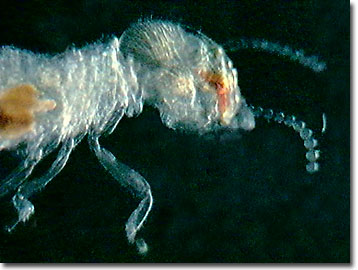Darkfield Digital Image Gallery
Termite
In the insect order Isoptera, termites rule the roost. The scientific name refers to the two pairs of equal length wings featured by reproductive adults. Although socially advanced like ants, termites are closely related to the more primitive cockroaches. There are at least 2,750 recognized species placed in 285 genera worldwide, with most tropical or subtropical in distribution.

View a low magnification image of termites.
View a high magnification image of termites.
Termite families are built on monogamy. Of all the animals on the Earth, termites might be the most monogamous. Rather than a "colony", termites live in a large, integrated family. There are three basic castes in a termite colony: workers, soldiers, and reproductives. When the eggs hatch, the larvae are totipotent, meaning that they can develop into any of the family's castes. The role an individual termite plays in the group is dependent on diet, season, and pheromones. Alates, or winged termites, represent the reproductives and each species' alates fly at a specific time of the day and under specific environmental conditions.
Infamous for their damaging diets of wood, termites also feed on other cellulose-containing matter including leaf litter, dead herbs, grasses, and humus. While termites are capable of digesting cellulose, they use symbiotic intestinal bacteria and protozoa to digest lignin. Although the bane of homeowners and linemen, termites support a large proportion of tropical biodiversity by continuously converting lignocellulosic biomass to insect matter, and thereby, preventing a huge biomass sink tied up in wood production.
Their propensities for destroying lumber and other wood products have made termites the target of several potent pesticides, most notably the chlorinated hydrocarbon chlordane. Despite the Environmental Protection Agency's ban of chlordane in the 1970s, it is still leaching from treated foundations into aquatic ecosystems and found biomagnifying in the tissues of fishes and humans. These hungry insects have also created a demand for a wood treatment industry that has featured toxic and resilient chlorinated hydrocarbons such as pentachlorophenol and pressure treatment with chromated copper arsenate. In the face of these toxic treatments, just as with roaches, termites continue to thrive throughout the tropics and subtropics.
Contributing Authors
Cynthia D. Kelly, Thomas J. Fellers and Michael W. Davidson - National High Magnetic Field Laboratory, 1800 East Paul Dirac Dr., The Florida State University, Tallahassee, Florida, 32310.
BACK TO THE DARKFIELD IMAGE GALLERY
BACK TO THE DIGITAL IMAGE GALLERIES
Questions or comments? Send us an email.
© 1995-2025 by Michael W. Davidson and The Florida State University. All Rights Reserved. No images, graphics, software, scripts, or applets may be reproduced or used in any manner without permission from the copyright holders. Use of this website means you agree to all of the Legal Terms and Conditions set forth by the owners.
This website is maintained by our
Graphics & Web Programming Team
in collaboration with Optical Microscopy at the
National High Magnetic Field Laboratory.
Last Modification Friday, Nov 13, 2015 at 01:19 PM
Access Count Since September 17, 2002: 8540
Visit the website of our partner in introductory microscopy education:
|
|
